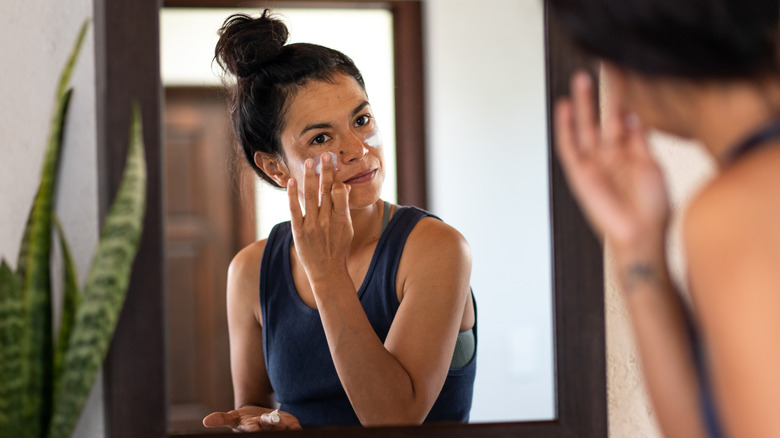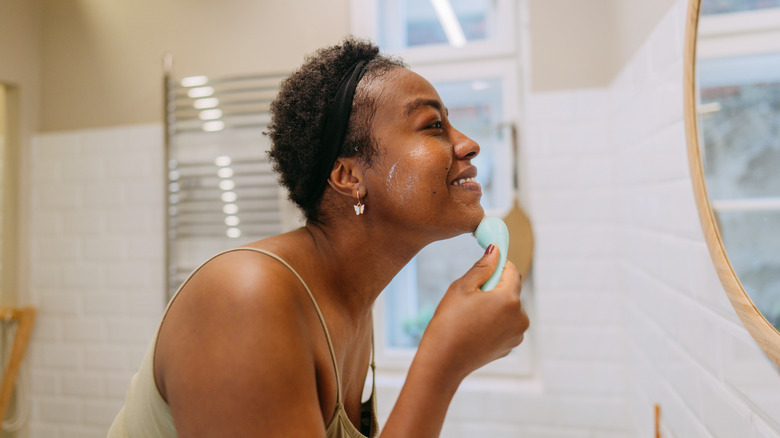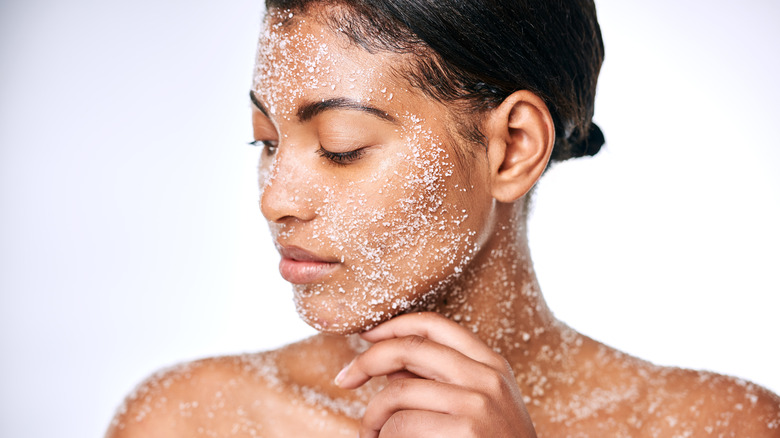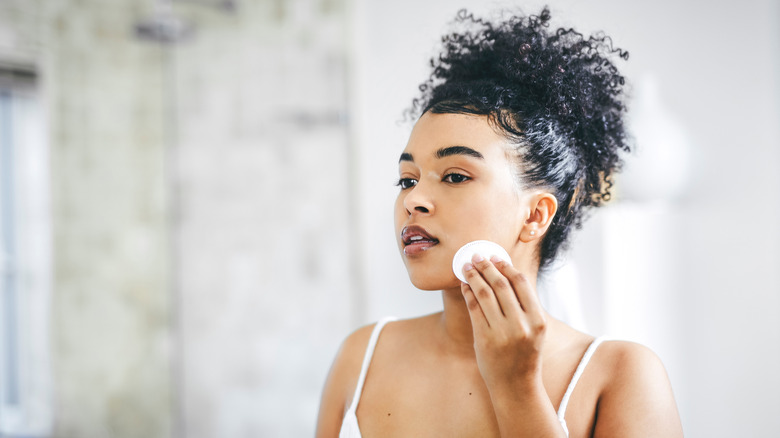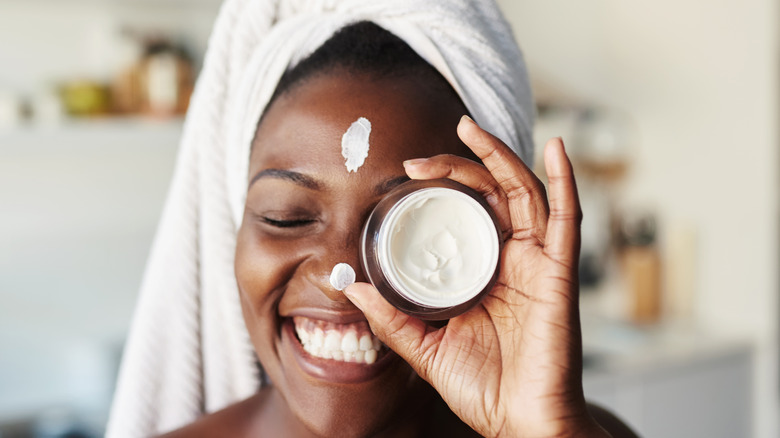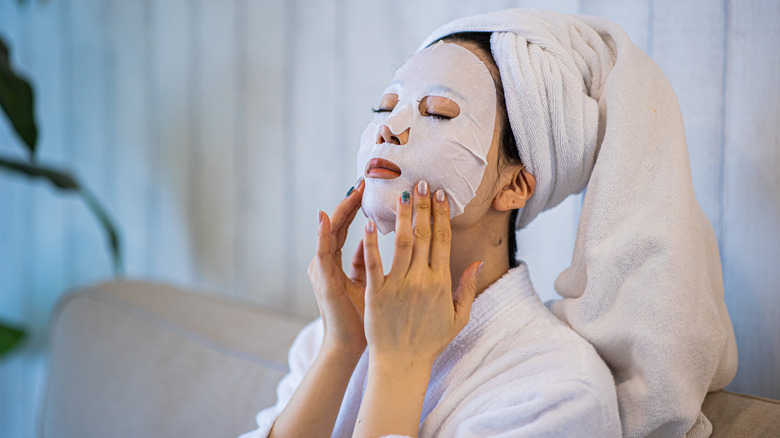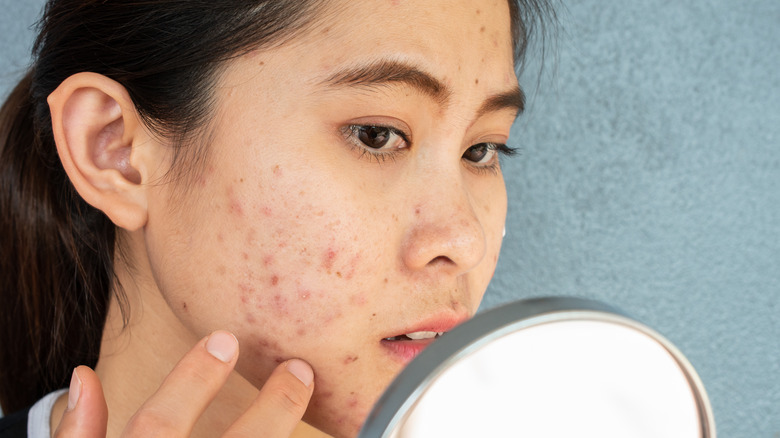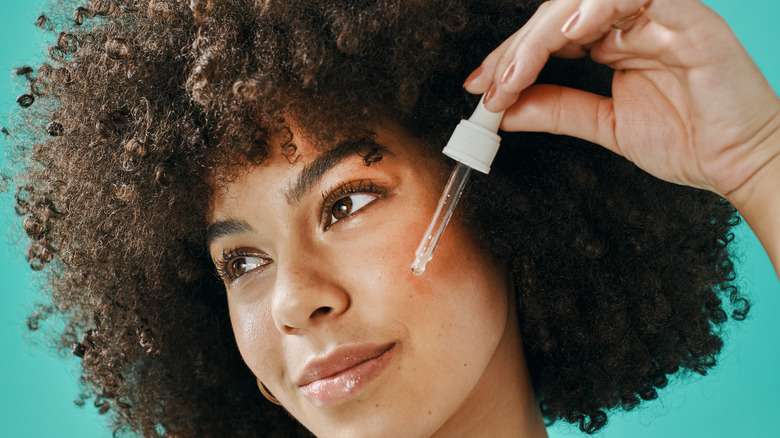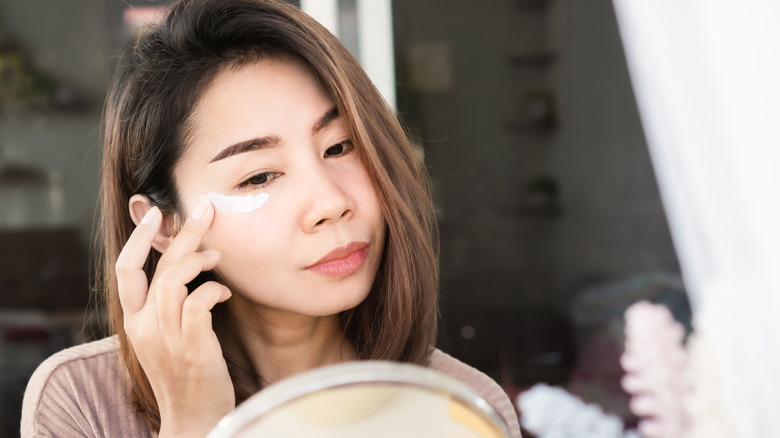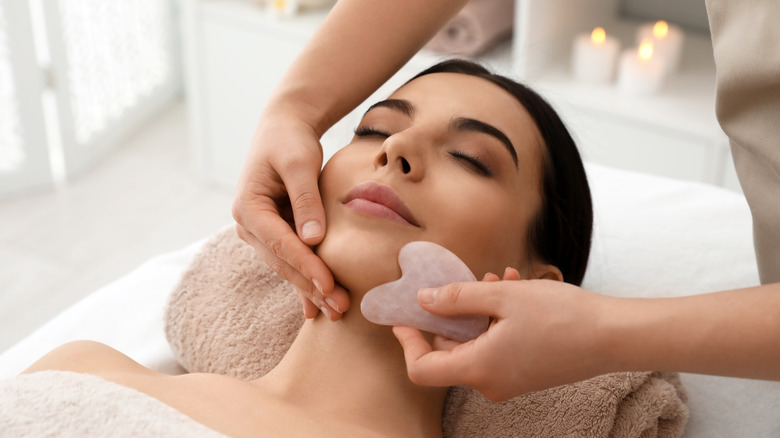How Long Should You Take For Each Of Your Skincare Steps? Here's What To Know
Mastering the art of skincare is no easy task. Between trying to find ingredients that work for your skin type, memorizing which skincare products to not mix, and trying to remember the difference between retinol and retinoid, there's a lot to know before you even put it on your face. But what many may not know is knowing what ingredients to use is only half the battle. There's also figuring out how long you should wait between each skincare step.
Although there is no consensus among dermatologist regarding the exact amount of time your routine should take, for the most part, the general rule of thumb is to move on to the next product once you feel the previous one is set in the skin. According to board-certified dermatologist Kim Nichols, this is important for ensuring they actually do their job, as well as minimizing the chances of any unusual reactions. "Certain product textures can roll up if you apply them immediately after one another," she explained to Allure.
Ultimately, how long you actually need to wait between each step depends on the products you're using and your specific skin type. If you're a seasoned skincare aficionado, you probably have this already down. But for others, figuring out when something has actually been absorbed is a little trickier. Thankfully, there some general guidelines you can follow for best results.
Cleansing time may vary
There's long been a debate about how long your cleanser needs to sit on your face. Per Healthline, some experts insist you need to actively wash for a full minute in order for your face to become truly clean. This is called the 60-second rule, and it's the protocol that aestheticians follow when washing a person's face during a facial. Licensed aesthetician Natalie Fairchild agrees, telling Allure, "Cleansing for 60 seconds, especially using an oil cleanser or balm, helps to soften the skin, clean out pores, and clean off all the pollution, makeup, and sweat from the day." However, it's important to remember that skincare is not one-size-fits-all, and this #60secondrule should be taken as a strict guideline, as different skin types may require different cleansing time. Those with oily skin may benefit from a longer scrub time than others. However, it's possible to over cleanse, especially if your skin feels dry or irritated after washing.
In any case, while there's no complete consensus, most experts would agree the sweet spot is somewhere at a minimum of 30 seconds.
Speaking to Everyday Health, cosmetic dermatologist Dr. Dendy Engelman shared, "Anywhere from 30 seconds to two minutes is optimal washing time."
If makeup is heavy, your skin may require oil cleansing the face twice.
Wait 30 minutes after using a chemical exfoliant
Unlike physical exfoliants, which rely on you physically rubbing grainy products on your skin to scrub away dirt, chemical exfoliants work by using active ingredients like acids to remove the surface layer of dead skin. Many people prefer them because they don't require any intense rubbing that could cause irritation. These typically come in the form of Alpha hydroxy acids (AHAs), like glycolic acid, lactic acid, and malic acids, or Beta hydroxy acids (BHA) like salicylic acid. Depending on your skin's needs, you may need one or the other, though those with acne prone skin are more likely to use BHAs. They typically come in the form of wipes, gel, or cream formulas.
Because there are so many different acid types, the general rule of thumb with how long they take up in your routine is to follow whatever the package instructions say. But if your product doesn't specify in the instructions how long to leave your exfoliant on the skin. Still, some experts recommend erring on the side of caution. Speaking to Glamour UK, Dr. Ana Mansouri advises, "I recommend waiting 20-30 minutes to ensure the skin is dry and to minimize inadvertent interactions."
However, per Allure, some experts say there actually isn't a set time, and it really depends on your specific skin type and how it reacts, more than anything.
Toner for redness and swelling
Preventing any redness or swelling is important when finishing off your skincare routine. Redness can occur for a number of reasons — eczema, acne, rosacea, and more — but thankfully, most conditions can be improved with creams, toners, and other healing ingredients. According to board-certified dermatologist Dr. David Bank, there are a few ingredients you should look out for when buying products for redness and swelling. "Products containing niacinamide, sulfur, allantoin, caffeine, licorice root, chamomile, aloe and cucumber can help reduce redness," he explained to Today.
Apply toner to a cotton pad and wipe it gently across the face, spending about a minute to ensure skin is evenly coated with the product. The thin and serum-like consistency will only need a few gentle swipes across the face, according to Allure. Start at the chin, work up to the t-zone, and finish with an upwards neck massage.
How long you need to wait between toners will likely depend on the ingredients, but Per Paula's Choice, you can generally apply your serum as soon as you feel the toner is dry. If your toner contains an exfoliant, you may want to way a few minutes before applying another active like retinol right on top, if you notice your skin reacts.
Sunscreen takes a few minutes to fully absorb
According to dermatologist Dr. Sumayah Jamal, sunscreen is necessary even if you spend all day indoors. "I especially recommend now, that sunscreen contain some sort of protection from blue light, the kind of light that you get from computer screens and phones," she explained to Today. "We do not know the long-term effects of this exposure with regards to the skin."
If you're in a rush, you may be tempted to throw on foundation mere seconds after rubbing in your sunscreen. Unfortunately this may be not working in your favor. Per Cleveland Clinic, applying other products too soon can actually mess with your SPF's ability to do its job. In fact, according to The New York Times, you need to wait at least two minutes before applying any other products on top of sunscreen to ensure it's fully absorbed. However, The American Academy of Dermatology states that sunscreen can take as long as 15 minutes to fully absorb into your skin.
When applying sunscreen to the face, opt for a minimum of SPF 30. Be sure to target the neck, ears, and decolletage, too. And above all, check to make sure your product isn't expired.
Moisturize for a full minute to get the benefits
Dedicating at least a minute or two to applying serums and moisturizers is the best way to properly hydrate the skin. Mix a liquid hydrating serum with your daily moisturizer and apply to the face, getting all the way down to the neck (because it's never too early to treat your neck). According to board-certified dermatologist Dendy Engelman, there's a process that requires serums to go on first. "We want to layer starting with the smallest molecule and gradually get larger," she explained to Allure. "A good rule of thumb is to start with the lightest product and finish with the thickest, allowing each layer to be fully absorbed by the skin."
Face masks can stay on for 10 to 15 minutes
Face masks should be worn for 20 minutes at most — the ideal time is around 10-15 minutes. According to board-certified dermatologist Dan Belkin, leaving cleansing masks on for too long can cause less-than-ideal results. "A cleansing mask may have surfactants that strip oil from the skin and over-applying these can lead to irritant dermatitis, where the skin becomes red and burning," he explained to Real Simple. You may have had your own experience with this, where the skin on the surface turns red after removing a face mask. Once the mask has been left on for an appropriate amount of time, follow up with your favorite moisturizer to lock in hydration and efficiently seal your skin's first layer.
Acne and spot treatments
Acne treatments have their well-deserved spot in our skincare routine, but they should only be left on for approximately 1 minute. While acne treatments need to soak into the skin, one minute is enough time for the ingredients to do their job, per Allure. Before rubbing the ointment alongside other creams, allow the spot treatment to sit on your face for a minute before gently rubbing it in. While the results of acne treatments don't show up immediately, it takes approximately 4-6 weeks to see improvement, according to the American Academy of Dermatology Association. If you notice even the slightest improvement within the expected time period, continue using the product consistently. If there are seemingly no improvements made, it's time to switch to a new and more effective acne treatment.
Retinol should sit on the skin for 10 minutes before applying anything else
Retinol is one of few high-quality skincare products that everyone should have, if circumstance and money allow. The vitamin A derivative sets itself apart by quickly sealing the firm surface of the skin. According to board-certified dermatologist Dr. Harold Lancer, retinol uses ingredients that "are of a different chemistry and will mix and absorb more rapidly," he told Allure. Thinner product consistencies require less time than thicker ones, meaning you shouldn't spend more than a minute rubbing retinol into the skin and down to your neck. Bonus points if you have a gua sha — we'll talk about this later.
Due to its potency, people use retinol as the last or second-to-last step in their skincare routine. Because of this, many experts recommend waiting a minimum of 10 minutes, and as long as 20 minutes before applying a moisturizer on top. This will prevent any potential reaction with other products or irritation. "Retinols are powerful antioxidants and it is important to allow it to fully absorb if you want to avoid your skin becoming sensitive," Dr Ioannis Liakis tells Glamour UK.
Under eye cream needs a few minutes to soak in
Once it's time to turn your attention towards the eyes, spend about two to three minutes applying under-eye cream and patting the product down with your fingers to achieve the ideal results. According to Kiehl's, skin around the eyes is especially sensitive and must be treated gently. Apply a few dots under the eye and use the ring finger to gently tap the under eyes and bring the product around to the corners, lids, and outer eye. Be careful not to get any product in your eye, but feel free to spend a few minutes making sure your skin has fully absorbed the product. You can also use tools that may enhance the experience, like a jade roller to spread the cream evenly.
You can spend several minutes using a gua sha
The longest and most relaxing part of a skincare routine can be gua sha. According to modern wellness expert Lin Chen, a gua sha tool can help with lymphatic drainage and other essential mechanisms of the body. "[It] is excellent for lymphatic drainage, addressing stagnant energy, promoting blood flow, soothing headaches, reducing inflammation, shortening acute illnesses like colds and flus and releasing tension from head to toe," she explained to CNN. The anti-inflammatory product can help reduce swelling, redness, and bloating. Spend about five minutes moving the gua sha at an angle across your face, being especially careful to move upwards (not down). Over time, you'll notice less puffiness in the cheeks and under the eyes — just make sure to stay consistent!
